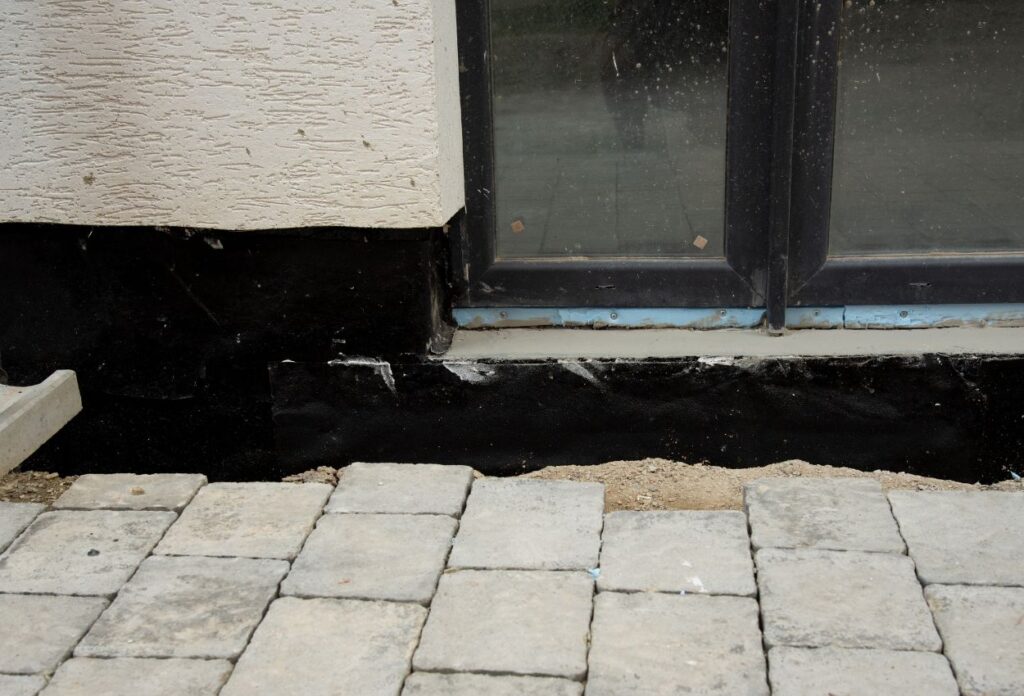Basements offer valuable space, but they also come with one major risk — water damage. If you do not pay attention, basement walls can allow moisture to get inside, leading to mold growth and even severe structural damage, all of which can be expensive to repair.
Homeowners in Oklahoma, where soil conditions and unpredictable weather can contribute to basement water issues, should take proactive steps to waterproof exterior basement walls.
Waterproofing your basement from the outside is the most effective way to prevent leaks and protect your home’s foundation. In this guide, we’ll explain what exterior basement waterproofing is, why it’s necessary, and how professionals do it the right way.
Why Exterior Basement Waterproofing Matters
Unlike waterproofing methods that are utilized for the interior of a home, specifically the basement, exterior waterproofing stops water before it reaches your foundation. This proactive approach:
- Prevents structural damage: Excess moisture can weaken concrete and mortar, leading to cracks and foundation shifting.
- Keeps mold and mildew at bay: Damp basements allow mold growth to occur quickly, causing health issues.
- Reduces hydrostatic pressure: Water buildup in the soil around your home can exert pressure on basement walls, causing leaks and cracks.
- Enhances property value: A well-maintained, dry basement is a major selling point for homeowners.
Also Read: Dos and Don’ts For Perfect Basement Wall Waterproofing
How to Waterproof Exterior Basement Walls

Waterproofing exterior basement walls is a step-by-step process that requires careful planning and expert execution. This is why we advise you to hire an expert for waterproofing. Here are some of the steps involved in exterior waterproofing and how professionals handle it:
Excavation
Since basements are below grade, to access the exterior basement walls, you first need to dig around the foundation down to the footing. This step requires specialized equipment and expertise to prevent damage to your home’s structure and the surrounding landscape. Generally, professionals charge on the basis of the size of the property and the amount of dirt that needs to be removed (usually calculated as per cubic yard). Excavation depth varies depending on the foundation type, but typically, it reaches about 6 feet.
Why is it important to excavate the perimeter? Because it gives access to the foundation walls. Heavy machinery such as backhoes or mini excavators is often used to dig efficiently, especially in areas with compacted or clay-rich soil.
Injuries can happen, so it is important to take protective measures to prevent accidental damage to underground utilities, landscaping features, or adjacent structures.
Cleaning and Inspecting the Walls
After excavation, it’s time to clean the foundation walls. Since they are covered with soil, they are bound to get filled with dirt and it’s important to clean the walls thoroughly and get rid of dirt, debris, and old coatings.
Our professionals not only clean the walls but also inspect for cracks, deteriorating mortar, or other signs of water penetration. We ensure that the wall is damage free, and even if there is some damage, it is repaired before moving ahead.
How To Clean Foundation Walls
Cleaning is often done using wire brushes, pressure washing, or even chemical solutions to remove stubborn grime. If there are any cracks or structural issues, these are carefully evaluated. Minor cracks can be sealed with hydraulic cement. However, if the condition of your basement is not good and there are larger structural problems, then you might require epoxy injections or additional reinforcement.
The goal is to create a smooth, clean surface that allows waterproofing materials to adhere properly, ensuring long-term effectiveness.
Applying Waterproof Coatings
A high-quality waterproofing membrane or coating is applied to the exterior foundation walls. The walls of the basement are usually concrete, which makes them prone to moisture. This is where applying an additional layer of coating helps.
Liquid Rubber Membrane
A seamless, flexible coating that forms a waterproof barrier. This type of membrane is popular due to its ability to stretch with foundation movement without cracking. It is typically sprayed or rolled onto the surface in multiple layers for added protection.
Cementitious waterproofing
A durable, brush-applied layer often used on concrete foundations. Cement-based coatings bond well to masonry surfaces, providing a rigid waterproof layer. These coatings can also include additives to increase their water resistance and durability.
Bituminous coating
You might not have heard about this much but it is effective. This is a thick, tar-like substance that resists water penetration. Bitumen-based waterproofing is highly effective, often reinforced with additional membranes such as fiberglass or polyester fabric. It is commonly used in conjunction with drainage systems to provide a full waterproofing solution.
Installing Drainage Systems
Waterproofing works best when excess water is properly redirected away from the foundation. The most effective way to do this is by installing a French drain. A French drain is a perforated pipe placed along the footing to collect and carry water away from the home. The pipe is covered with gravel and a fabric filter to prevent clogging from soil particles.
To avoid the soil directly touching the walls, you can also use the gravel backfill method. This is used around the pipe to help water flow away more easily. This way, water can move toward the drainage system instead of building up against the walls of the foundation.
Some homeowners also opt for an exterior sump pump in areas with high water tables. This pump actively removes water before it can reach the foundation walls, providing an additional layer of protection.
To learn more about sump pumps, check out our guides:
- What Is A Sump Pump and How Does It Help Your Basement?
- Types Of Sump Pumps to Keep Your Basement Dry
Soil ‘Backfilling’ and Landscaping
Once all waterproofing measures are in place, the excavated area is carefully filled in with soil. In technical terms, this process is often called ‘backfilling’ as the same soil is placed and compacted to prevent settling. While doing this, you want to ensure that the soil slopes away from the foundation to encourage proper drainage.
Using the right type of soil is critical in this step. Clay-heavy soil should be avoided as it tends to retain water easily, while sandy or loamy soils allow better drainage. Proper compaction is also necessary to prevent future settling, which could compromise the waterproofing efforts.
Adding a Drainage Board (Optional)
If you live in an area that receives frequent rainfall, you can install a drainage board for added safety. This is placed over the waterproof coating to create a protective barrier between the soil and foundation. This dimpled plastic or composite material prevents water from accumulating against the walls and helps direct it toward drainage pipes.
Though not their primary benefit, drainage boards also serve as insulation in some cases. The air gaps created by the board help relieve hydrostatic pressure, further reducing the risk of leaks. These boards are mechanically fastened or adhered to the waterproof membrane, ensuring a secure fit.
How Gutters Help Protect Your Basement!
Yes, we know that gutters are located at the top of your home, so how do they help protect your basement from flooding?
Gutters and downspouts direct rainwater away from your foundation. When they’re working properly, they prevent water from overflowing and pooling around your basement walls, which can lead to leaks and flooding.
Keep Gutters Clean
Regularly inspect your gutters, especially after heavy downpours or storms as this is the time when gutters get clogged with leaves. Clogged gutters allow water to overflow the gutter channels and fall directly around the foundation.
Extend Downspouts 6 Feet Away From The Home
From the gutters, the rainwater travels down through the downspouts. Make sure downspouts discharge water far from the base of your home to prevent it from seeping into your basement.
Grade the Ground Around Your Home
Grading is a good option to ensure the ground slopes away from the foundation so water doesn’t pool near the basement.
By maintaining your gutters, you keep water away from your home’s foundation, reducing the risk of basement flooding.
Oklahoma’s Leading Basement Waterproofing Contractor
Proper exterior basement waterproofing involves a lot of things that need to be just right. This is why it is better to hire a professional roofing contractor if you find yourself waterproofing your basement.
If your basement is vulnerable to moisture damage and you want to ensure that it does not happen again, then look no further than the team of A. Fricker Roofing and Waterproofing. We have been serving Oklahoma homeowners for years and are experienced in both exterior and interior basement waterproofing. Contact us today at (918) 402-7167 to find out how we can help you.

